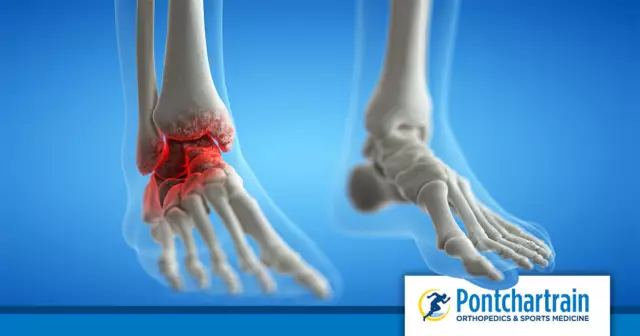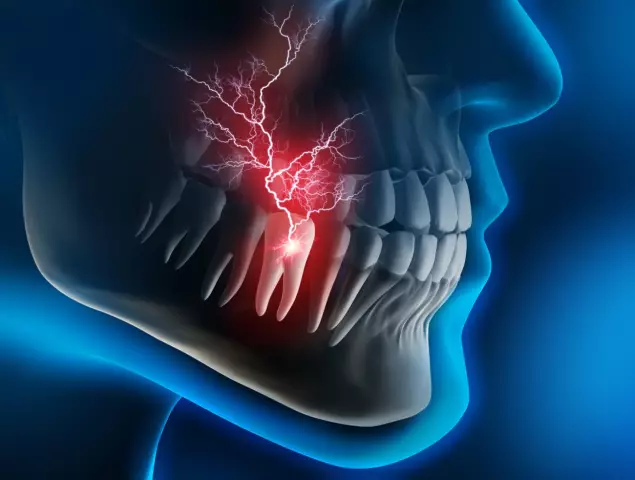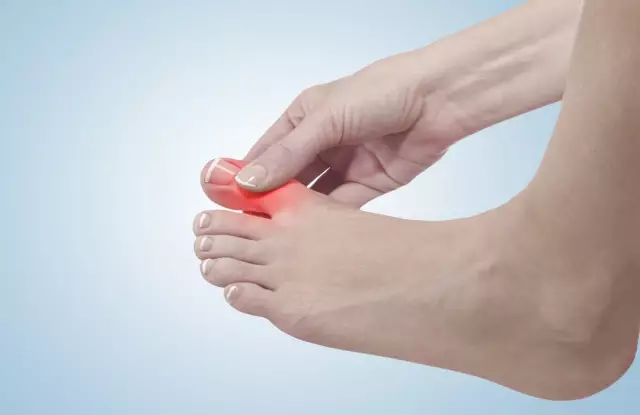- Author Rachel Wainwright [email protected].
- Public 2023-12-15 07:39.
- Last modified 2025-11-02 20:14.
Why does the ankle often hurt?

The ankle is a bone formation in the lower leg area that is part of the ankle joint. Its purpose is to transfer weight from foot to foot, as well as shock absorption. The ankle is the second most popular injury site for athletes and hikers (knee comes first). But even in everyday life, this segment of the ankle is exposed to various pathological conditions that cause certain unpleasant sensations. So, let's look at the main reasons why ankle hurts.
Fracture: when the ankle hurts unbearably
Fracture is perhaps the most common injury to the ankle, which occurs when loads significantly exceed the strength of the bones and ligaments in the lower leg. There may be several reasons why the ankle hurts as a result of a fracture:
- Rolling up of the foot;
- Excessive or too intense flexion or extension of the joints;
- Twisting the joint;
- Hit.
Such unnatural stresses occur during sports, slipping on ice, jumping from great heights, as well as in road accidents and other accidents.
If your ankle hurts because of a fracture, it is usually so bad that it will force you to see a traumatologist. In addition to pain, the symptoms of a fracture are:
- Swelling in the ankle area
- Bruising on the ankle that appears several days after the injury;
- Deformation of the ankle joint;
- Abnormal mobility of the ankle;
- With an open fracture, a wound with bone fragments.
If your ankle hurts and you suspect a fracture, call emergency medical help, and before she arrives, keep your leg completely rest and immobile by placing it on an elevated position to help reduce the development of edema. In addition, dry cold will relieve the condition - an ice pack or a plastic bottle of cold water (can be applied for 20 minutes).
For this type of ankle pain, treatment can be conservative or operative, including reduction, limb fixation, osteosynthesis, etc.
Ankle hurts as a result of sprains
Sprains are more common than fractures and vary in severity:
- A first-degree sprain is characterized by mild pain without restriction of mobility, the ankle hurts and swells slightly
- Second-degree sprains include severe swelling, subcutaneous hemorrhage in the affected area, pain when walking, abnormal joint mobility;
- A third degree sprain is severe swelling, extensive hematoma, unstable ankle joint, lack of resistance during stress tests, and absolute inability to move.
For first-degree trauma and ankle pain, treatment can be self-directed. But it is worth remembering that in such cases, massage and rubbing of the sore spot, as well as taking hot baths, are unacceptable - these actions will provoke the development of inflammation and edema. Second and third degree injuries require medical attention. As in the case of a fracture, when the ankle hurts during sprains, it is necessary to ensure rest and apply a dry cold compress, keep the injured leg elevated, and take anti-inflammatory and pain relievers.
Inflammatory and degenerative diseases of the joints and ligaments
This group of diseases is characterized by the following symptoms: unlike sprains and fractures, the pain is not sharp at first, but as the inflammatory process develops, it intensifies, gradually limiting mobility. Typically, the ankle hurts the most when walking. Such diseases include rheumatoid arthritis, arthrosis, tendonitis, bursitis.
Rheumatoid arthritis is a systemic connective tissue disorder that is more common in women than men. Usually, the disease first affects the phalanges of the fingers, hands, and only then the knee, elbow and ankle joints. Therefore, if you find these signs, and then notice that your ankle hurts when walking and the discomfort increases with changing shoes and moving up stairs, the first suspect is arthritis. The reason why the ankle hurts is because rheumatoid arthritis affects the ankle, causing inflammation. The disease manifests itself in the form of edema in the ankle area, joint instability, which causes frequent subluxations. For ankle pain, treatment requires anti-inflammatory drugs, cortisone injections, and in advanced cases, surgery is indicated.
Osteoarthritis is a degenerative joint disease that occurs both due to excessive exertion and due to common diseases such as diabetes mellitus and gout. In women, the risk of arthrosis is increased by the constant wearing of high-heeled shoes. This disease also affects professional runners, football players, ballerinas. It is not difficult to determine why the ankle hurts in these cases - with arthrosis, the cartilages age, become thinner and lose their plasticity. The overgrowing bone tissue can lead to joint deformities, while the ankle hurts when walking and at rest. But arthrosis in the early stages can be slowed down and stopped. You should be alerted by symptoms such as "starting" pain at the beginning of movement, discomfort during exertion, in the morning, crunching and creaking in the joints, stiffness of movements, curvature of the lower leg axis.

Tendinitis is an inflammation and degeneration of tendon tissue that can result from physical exertion, injury, infection, autoimmune diseases, metabolic disorders, neuropathies, etc. With tendinitis, the sensations of ankle pain range from tolerable discomfort to burning pain with stiff joints. It can be observed at rest, but the ankle hurts much more when walking and after movement. For ankle pain, tendonitis is usually treated conservatively, including analgesics and anti-inflammatory drugs other than steroids. However, in this case, the elimination of the causes of the disease described above comes to the fore.
The reason why the ankle hurts may be bursitis affecting the Achilles tendon. Bursitis is inflammation of a bursa, small, fluid-filled sacs located at the interface between bones, tendons, and ligaments. Ankle bursitis occurs mainly as a result of excessive stress and is most often found in young athletes, skaters, as well as in adolescent girls who begin to wear high-heeled shoes. The pain radiates to the heel and increases with movement. For bursitis and ankle pain, treatment includes taking non-steroidal anti-inflammatory drugs, applying a plaster cast, wearing instep supports, and eliminating the causes of the disease.
If your ankle hurts, and these unpleasant sensations are constant, then with a high probability they will increase as the disease progresses. Therefore, having found an alarming symptom, do not delay the visit to the doctor. In your case, you need to contact a traumatologist or rheumatologist.
Found a mistake in the text? Select it and press Ctrl + Enter.






